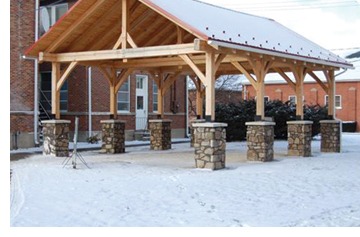September 2013: From the Editor
Words: Dan Kamys
From the Editor
Jennifer Morrell
Editor
jmorrell@lionhrtpub.com

I recently was copied on an email from an Alfred State College (Wellsville, N.Y.) professor to a group of masonry industry professionals. The professor, Stephen B. Richard, teaches masonry building trades at the college’s School of Applied Technology. The email served as a letter of thanks for all that the recipients did to assist in the masonry program.
My first thought, upon reading the email, was that the project turned out nicely, and it was wonderful to see a masonry program alive and well at this college. But after reading it again, my thoughts ran much deeper. I took a look at the email addresses of the recipients. Everyone from architects to suppliers was included – each one of them having clearly made a difference. The email went to dozens of people. It was remarkably heartwarming.
And then, something else stood out in his letter: the reference to masons as “the human factor.” You know, he’s right. The materials are fool proof. You masons make the ultimate difference as perfectionists at an age-old, time-tested craft that still is very much needed today.
I encourage you to extend your hand and your resources to masonry education and educators nationwide. And, when you do, let me know about it by emailing me at jmorrell@lionhrtpub.com. Professor Richard’s letter is below.
Hello to all,
 First, I want to thank all of you for the many contributions you have made to our quality masonry education here at Alfred State College. You have donated materials, brought seminars to our campus, hosted visits, provided consulting, judged skill competitions, and funded educational opportunities for the students, Mr. Zver and me.
First, I want to thank all of you for the many contributions you have made to our quality masonry education here at Alfred State College. You have donated materials, brought seminars to our campus, hosted visits, provided consulting, judged skill competitions, and funded educational opportunities for the students, Mr. Zver and me.
We are not engineers.??We are not architects.
We are installation experts. Installation – the human factor – is the weakest component in masonry systems. Brick, CMUs, stone and properly specified mortar always are predictable and perform well.
With your help, we are able to keep abreast with the??best practices for masonry construction and pass them on to students. I am happy to say we still are experiencing full enrollment in our program.??It is satisfying to see young people who want to work hard with their hands and minds.
Masonry construction is the original sustainable and green system.??It is resilient!
Thanks again,
Stephen B. Richard
Associate Professor, Masonry Building Trades
ASC School of Applied Technology
607-587-3157, RicharSB@alfredstate.edu
Return to Table of Contents